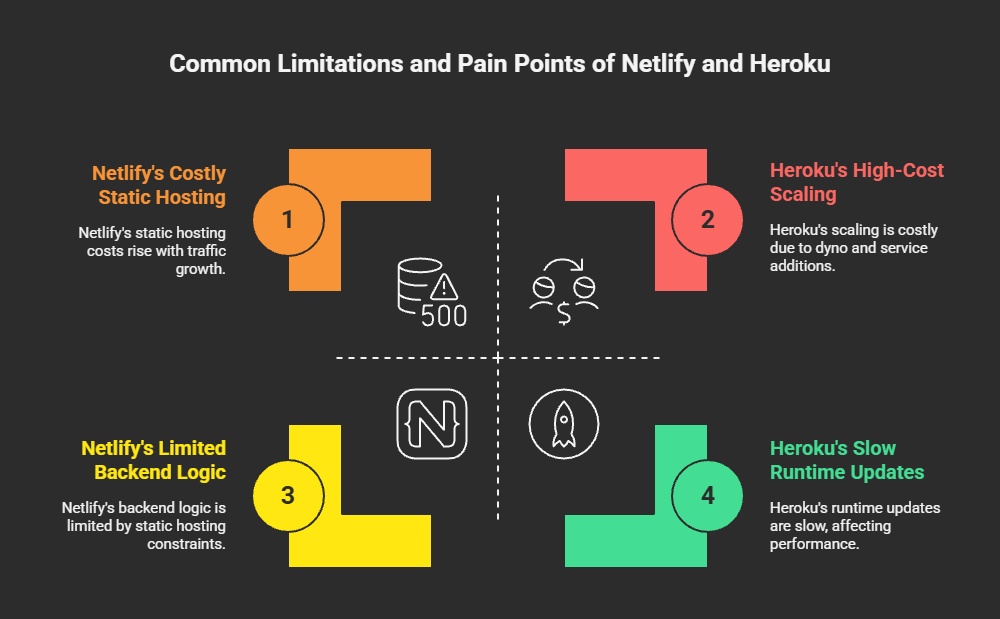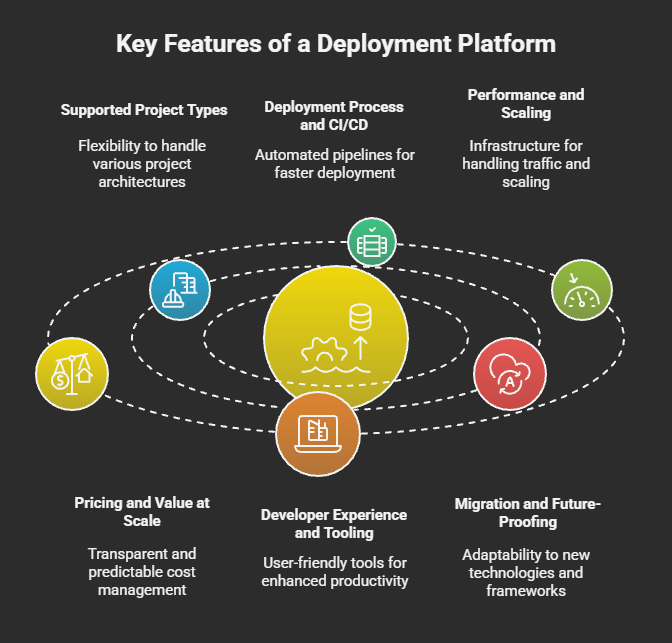Published
- 14 min read
Netlify vs Heroku: Which deployment tool is better for your project?

When it comes to deploying and hosting modern applications, Netlify and Heroku are two of the most well-known names. Both promise to simplify the path from code to live app, but they approach the problem in very different ways.
Netlify is known for its Jamstack-focused hosting, making it a go-to choice for static sites, marketing pages, and frontend projects. Heroku, on the other hand, offers a full-stack PaaS that can handle backend applications, APIs, and databases without complex server management.
But there’s the catch.
While each platform has its strengths, developers often run into limitations as their projects grow.
That’s why in this guide, we’re not only going to compare Netlify vs Heroku in detail but also show you why Kuberns, an AI-powered deployment Platform, could be a smarter long-term choice.
If you’re deciding between Netlify and Heroku in 2025, or exploring the best Netlify alternatives and Heroku competitors, this comparison will give you the clarity you need and possibly a third option you hadn’t considered.
What is Netlify?
Netlify is a Jamstack-focused hosting and deployment platform designed for speed, simplicity, and automation. It’s built to serve static websites, marketing pages, and frontend projects that don’t require heavy backend infrastructure. Developers connect a Git repository, and Netlify handles the build, deploy, and hosting process automatically.
However, it’s less suitable for backend-heavy or full-stack apps.
Best for: Frontend projects, static sites, marketing pages
Limitations: Less backend support, pay-per-usage can scale unpredictably
What is Heroku?
Heroku is a Platform as a Service (PaaS) that simplifies backend app deployment for developers. It allows you to deploy web apps and APIs with minimal infrastructure management using “dynos”, virtual containers for running code.
Heroku is popular for rapid prototyping, small-to-medium backends, and early-stage SaaS projects, due to its ease of use and support for multiple languages and frameworks like Node.js, Python, Ruby, and Java.
Best for: Dynamic apps, APIs, early-stage startups
Limitations: Performance bottlenecks, scaling costs, legacy architecture
What is Kuberns?
Kuberns is an AI-powered deployment platform that bridges the gap between Netlify’s simplicity and Heroku’s flexibility. It supports both static and dynamic workloads, making it equally suited for Jamstack sites, backend APIs, microservices, and even Kubernetes-scale deployments.
Unlike most platforms, Kuberns comes with built-in CI/CD pipelines, automated scaling, performance monitoring, and secure environment management, all without requiring separate tools or complex configurations.
One of Kuberns’ standout advantages is cost efficiency.
By hosting on optimised AWS infrastructure, it can help you save up to 40% on cloud costs, making it ideal for teams that want scalability without overspending.
Best for: Full-stack apps, scalable APIs, Jamstack, startups, and teams
Why it matters now: In 2025, developer teams demand tools that grow with them, without complex DevOps or rising costs.
Common Limitations and Pain Points of Netlify and Heroku
 Choosing a platform isn’t just about features. It’s about how well it holds up as your project evolves.
Choosing a platform isn’t just about features. It’s about how well it holds up as your project evolves.
While Netlify and Heroku both offer easy onboarding, many teams eventually run into roadblocks that stall growth, complicate workflows, or inflate costs.
Below are some of the most common challenges developers face when building on these platforms in 2025.
What Developers Don’t Like About Netlify
While Netlify is excellent for static and frontend-driven projects, developers often find it limiting when their application needs more than static hosting. Running complex backend logic or large-scale dynamic content usually requires workarounds or external services.
Netlify’s free tier can be generous at first, but build minute caps, function execution limits, and bandwidth restrictions can quickly lead to unexpected costs as traffic grows.
Additionally, its serverless functions are restricted in execution time and cold start performance, which can be problematic for more complex applications.
Heroku Limitations for Modern Teams
Heroku’s simplicity comes at a cost, both literally and technically.
Pricing scales up quickly as you add dynos, databases, or additional services. Teams often find themselves locked into higher tiers to maintain performance, which can strain budgets.
From a technical standpoint, while Heroku supports multiple languages and frameworks, it can be slower to adopt the latest runtime versions or infrastructure features. For applications that need low latency or global distribution, Heroku’s architecture isn’t as edge-focused as modern deployment platforms.
When You Might Outgrow These Platforms
If your application starts small but is expected to grow significantly, you might hit scaling or feature walls with both Netlify and Heroku.
Netlify may require integrating multiple third-party services for full-stack functionality, while Heroku may become too costly and harder to optimise for performance.
These challenges often lead teams to look for the best Netlify alternatives or Heroku Alternatives that can handle diverse workloads without forcing them to re-platform later.
This is where Kuberns begins to stand out, offering a platform that scales seamlessly from MVP to enterprise without the usual trade-offs.
What to Look For in a Deployment Platform in 2025?
 When evaluating Netlify vs Heroku or any modern deployment tool, it’s important to look beyond just getting your app online.
When evaluating Netlify vs Heroku or any modern deployment tool, it’s important to look beyond just getting your app online.
A platform should support your current needs while making it easy to scale, optimise costs, and adapt to new technologies over time.
Supported Project Types
A strong deployment platform should handle everything from static Jamstack sites to complex, full-stack applications. This flexibility ensures you won’t need to migrate to a different platform as your architecture evolves.
Deployment Process and CI/CD
Built-in continuous integration and continuous deployment (CI/CD) pipelines can save hours of manual setup. A good platform should offer automated testing, seamless Git integration, and zero-config deployment flows to help teams ship faster.
Performance and Scaling
Performance isn’t just about page load speed. It’s also about handling traffic spikes, scaling without downtime, and delivering content globally. The best platforms provide edge delivery, auto-scaling, and low-latency infrastructure to ensure consistent performance anywhere in the world.
Pricing and Value at Scale
Low entry pricing can be misleading if scaling your project leads to steep cost increases. Transparent, predictable pricing with no hidden charges for bandwidth or build minutes is crucial for long-term cost control.
Developer Experience and Tooling
A developer-friendly platform should reduce complexity, not add to it. Clear documentation, intuitive dashboards, robust monitoring tools, and responsive support make a huge difference in daily productivity.
Migration and Future-Proofing
Your deployment platform should adapt as technology changes. Support for modern frameworks, containerization, microservices, and AI-driven automation helps ensure your stack stays competitive without major rewrites.
Why Kuberns May Be the Smarter Choice in 2025
 Choosing between Netlify and Heroku often feels like picking between simplicity and flexibility. But in 2025, that trade-off no longer needs to exist.
Choosing between Netlify and Heroku often feels like picking between simplicity and flexibility. But in 2025, that trade-off no longer needs to exist.
Kuberns was built to eliminate the compromises developers face when working with legacy platforms using AI-driven infrastructure, built-in CI/CD, and intelligent cost optimisation to help teams launch faster and scale smarter.
Here’s why more teams are switching to Kuberns:
All-in-One Flexibility
Kuberns supports static sites, dynamic backends, microservices, and even enterprise-level Kubernetes deployments. You can start with a small marketing site and grow into a complex SaaS without switching platforms or reworking your infrastructure.
Built-in CI/CD and Automation (Zero setup pipelines)
No need to configure separate CI/CD tools. Kuberns provides fully integrated pipelines that connect to your Git repositories, run automated builds and tests, and deploy your app in just a few clicks, all without YAML files or complex scripts.
Cost Efficiency (Save up to 40% on AWS costs)
By running on optimised AWS infrastructure, Kuberns passes significant savings back to you. You can scale your workloads while paying less, avoiding the steep cost jumps that come with Heroku’s dynos or Netlify’s usage tiers.
Scale Without Replatforming (Grow from MVP to enterprise without hitting limits)
Whether you’re hosting a small side project or running a multi-region production app, Kuberns auto-scales resources without downtime. You won’t need to migrate when your traffic grows or when you need features like container orchestration.
Transparent Pricing (No surprise charges for bandwidth or build minutes)
Kuberns offers predictable, easy-to-understand pricing. You won’t get unexpected bills for exceeding function execution time or bandwidth limits, a common frustration with other platforms.
Conclusion (Skip the Trade-Offs)
Choosing between Netlify vs Heroku often comes down to deciding what you’re willing to sacrifice. Netlify offers speed and simplicity for static and frontend-driven projects, but struggles when you need complex backend capabilities.
Heroku delivers more flexibility for dynamic applications, but can quickly become expensive and less performance-focused at scale.
The truth is, you don’t have to pick one and live with its limitations.
Kuberns combines the best of both worlds. The ease of Netlify, the flexibility of Heroku, and the scalability of enterprise-grade infrastructure. With built-in CI/CD, AI-powered scaling, global performance optimisation, and up to 40% AWS cost savings, it’s designed to grow with your project from the first commit to millions of users.
With Kuberns, you’re not choosing between simplicity and flexibility. You’re getting both, along with predictable pricing and a platform that won’t hold you back.
Start your free deployment today at Kuberns and see how easy it can be to build, deploy, and scale without compromise.

People Also Ask
1. Is Netlify better than Heroku? A: Netlify is better for static websites, marketing pages, and frontend projects that benefit from fast global CDN delivery and Jamstack architecture. Heroku is better for dynamic applications, backend APIs, and full-stack workloads. If you need a single platform that handles both, Kuberns combines Netlify’s simplicity with Heroku’s flexibility. 2. Which is cheaper, Netlify or Heroku? A: Netlify offers a generous free tier for static sites, but costs can rise with higher build minutes, function usage, or bandwidth. Heroku’s pricing scales up quickly as you add dynos and databases. Kuberns provides predictable pricing with no hidden costs, helping teams save up to 40% compared to AWS-hosted equivalents. 3. Can Netlify run backend code like Heroku? A: Netlify can run backend logic through serverless functions, but these have execution time limits and may not be suitable for complex APIs. Heroku supports persistent backend services with full language runtime support. Kuberns supports both approaches in one platform, allowing you to mix static hosting and full backend services seamlessly. 4. Which platform is faster, Netlify or Heroku? A: Netlify is generally faster for static content because it delivers pages from a global CDN. Heroku performance depends on dyno type, location, and app architecture, and may not match CDN-level speed for static assets. Kuberns delivers both static and dynamic content at edge-level performance, optimized for global reach. 5. What is the best alternative to Netlify and Heroku? A: If you want to avoid the trade-offs of Netlify’s limited backend support and Heroku’s scaling costs, Kuberns is a strong alternative. It’s an AI-powered deployment platform that supports static sites, dynamic apps, and Kubernetes workloads in one place, with built-in CI/CD and automated scaling. 6. Is there a platform that combines Netlify and Heroku features? A: Yes. Kuberns offers one-click deployment for both frontend and backend apps, built-in CI/CD, AI-powered scaling, and up to 40% cost savings, combining the strengths of Netlify and Heroku without their limits. 7. What are the best alternatives to Netlify and Heroku in 2025? A: The top alternatives include Kuberns, Vercel, Render, and Railway. Kuberns stands out by supporting full-stack deployments, Kubernetes workloads, and offering cost optimisation powered by AI. 8. Can I migrate from Netlify or Heroku to Kuberns easily? A: Yes. Kuberns supports fast migration from both Netlify and Heroku with minimal configuration. You can migrate static sites, APIs, or full-stack apps and deploy in minutes.